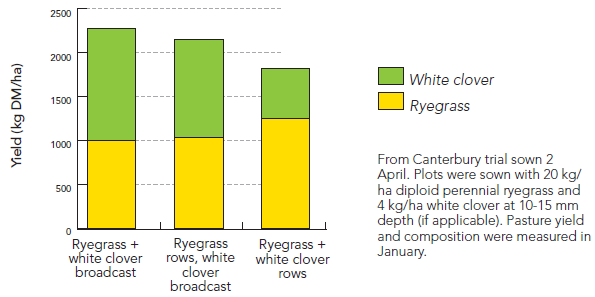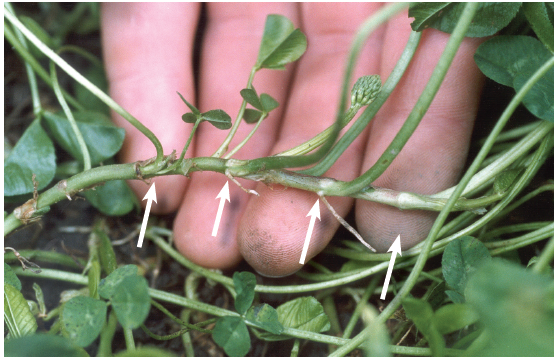Maximising white clover
White clover is a key component of NZ pastoral systems because of its high feed value, warm season growth and ability to fix nitrogen.
White clover is more difficult to establish in a pasture than grass. Care needs to be taken with soil fertility, sowing technique and cultivar choice. Clover content is also greatly influenced by on-going pasture management.
Soil fertility
Correct soil fertility is essential. Clover is sensitive to soil pH, growing best at 5.8-6.2. Ensure adequate levels of phosphate, sulphur and molybdenum. If lack of clover is on-going, herbage testing of any clover plants present can help provide answers.
Establishment
Careful establishment will help white clover thrive.
It has a small seed, requires shallow sowing (<5 mm), and is frequently sown too deep. Drilling ryegrass and clover in the same row through a coulter drill means competition from the faster establishing ryegrass suppresses clover (see graph below). Where possible don’t sow ryegrass and clover together in rows. If cultivating, roller drills are ideal. If your drill (or your contractor's) has a separate small seed box, one option is to order your clover seed separately, sow it through this, then roll.
Sowing method and clover
In this trial white clover and ryegrass were sown using three widely used methods. Nine months after sowing, broadcasting white clover seed gave on average 20% more clover in the pasture than drilling with ryegrass in a row.
White clover and ryegrass DM yields from different sowing methods

Maintaining good clover
Once established, white clover will perform best under rotational grazing, so it is frequently exposed to sunlight not shaded out under high grass covers. White clover is also preferentially grazed by stock, so continuous set- stocking often leads to over grazing and reduced clover levels.
Cultivar choice
We recommend two main clover mixes, one for dairy and cattle grazing, the other for sheep and deer. These both contain cultivars of two leaf sizes, to provide greater adaptability to climate, topography or management.
Ruru/Apex - Sheep/deer
This combination has smaller leaves, and is more tolerant of close grazing while still providing very good warm season production. Ruru with its medium leaf is complemented by Apex with a small leaf. Both have shown good tolerance to summer dry conditions or under clover root weevil attack.


